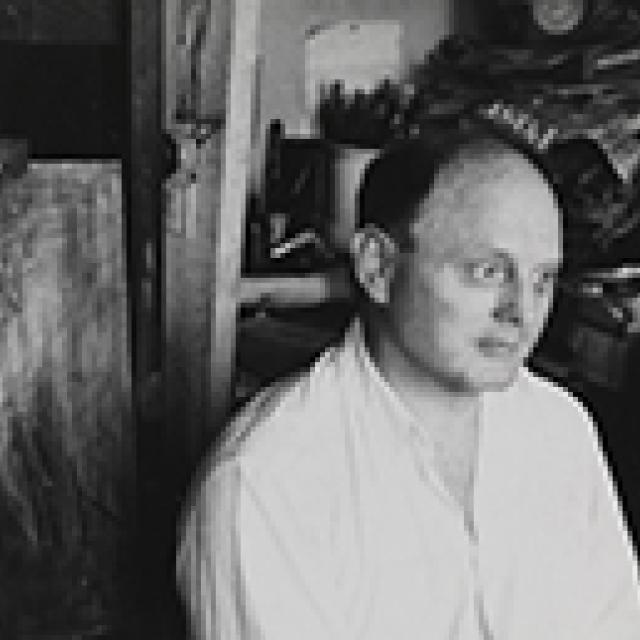
Reginald Marsh
American, born France, 1898 - 1954
Born in Paris, the son of American artists, Marsh came to the United States at age two. Growing up in Nutley, New Jersey, and New Rochelle, New York, he demonstrated a precocious talent for drawing. Marsh entered Yale University in 1916, where he served as art editor and cartoonist for the Yale Record. After graduation Marsh moved to New York City and pursued a career in illustration. His work appeared in the Evening Post, the Herald, Vanity Fair, and Harper’s Bazaar. In 1922 Marsh enrolled at the Art Students League and produced illustrations of vaudeville and burlesque performances for the Daily News. Marsh and his first wife, sculptor Betty Burroughs, traveled to Europe in 1925, where Marsh studied and copied old master paintings. In 1926 he returned to the Art Students League and was mentored by Kenneth Hayes Miller, who encouraged Marsh’s interest in documenting contemporary urban life.
Marsh’s drawings, paintings, and prints capture the crowded and colorful atmosphere of New York’s modern metropolis. Often teeming with lively human figures, his scenes depict many of the city’s iconic landmarks, including Times Square, the Bowery, and Coney Island, as well as seedier locales like subways and elevated trains, burlesque parlors and dance halls, back alleys and city streets. The artist returned often to his favorite spots, capturing his immediate impressions in his sketchbook and occasionally taking preparatory photographs. The regionalist painter John Steuart Curry explained what attracted his friend Marsh to New York: “It is the glistening, fabulous city, woven on the warp of a hundred foreign cities, multicolored with races and kinds and creeds, its people molded by its influence yet paradoxically individualized by its bigness; it is this magic, fascinating city that Reggie loves and paints.”[1]
In contrast with his modern subject matter, Marsh’s techniques recalled the old masters. He emphasized draftsmanship and employed the traditional mediums of watercolor and egg tempera recommended by his mentor, Miller. Marsh also produced over 250 prints, most of them etchings and engravings.
Marsh received his first solo exhibition at the Whitney Studio Club in 1924. Over the next three decades he was featured in numerous group and solo exhibitions in both museums and private galleries, including 15 one-man shows at the Frank K. M. Rehn Gallery. He continued to produce commercial work; in 1925 Marsh became one of the original cartoonists at the New Yorker, where he was a regular contributor until 1931. Along with many artists of his generation, Marsh participated in the New Deal’s federal art programs, painting two murals in Washington, DC, and a series of frescoes in New York. During World War II he served as an artist correspondent for Life magazine and traveled to Brazil to sketch the troops stationed there.
In addition to his own work, Marsh was an influential teacher. Beginning in 1935 he taught at both the Art Students League and then at Philadelphia’s Moore Institute, where he served as head of the department of paintings. In 1945 Marsh published Anatomy for Artists. This instructive text reflected his interest in modeling the human form and an appreciation for artists such as Michelangelo and Rubens, who were similarly concerned with depicting the body in space.
Even as modernization and development reshaped the urban landscape of his city, Marsh continued to paint vivid, vibrant views of New York. He died of a heart attack on July 3, 1954, in Dorset, Vermont, survived by his second wife, painter Felicia Meyer, whom Marsh had married in 1934.
[1] John Steuart Curry, “New Yorker,” Demcourier 13, no. 4 (1943): 15–16.
Explore Selected Works
Artwork

Archbishop Diomede Falconio
Archbishop Diomede Falconio
Thomas Eakins · 1905 · oil on canvas · Accession ID 1946.16.1
Artwork

P.R.R. Loco Waiting to be Junked
P.R.R. Loco Waiting to be Junked
Reginald Marsh · 1932 · etching, drypoint, and engraving in black on wove paper · Accession ID 2015.19.809
Artwork

Harbor with Boats at Anchor
Harbor with Boats at Anchor
Reginald Marsh · 1927 · watercolor over graphite on wove paper · Accession ID 2015.19.2790
Artwork

Steeplechase
Steeplechase
Reginald Marsh · 1932 · etching and engraving in black on laid paper · Accession ID 2015.19.808
Artwork

Figures on a City Street [verso]
Figures on a City Street [verso]
Reginald Marsh · c. 1940 · colored pencil and watercolor on wove paper · Accession ID 2015.19.2791.b
Artwork

Ship in a Harbor [recto]
Ship in a Harbor [recto]
Reginald Marsh · c. 1940 · watercolor and graphite on wove paper · Accession ID 2015.19.2791.a
Bibliography
1955
Goodrich, Lloyd. Reginald Marsh. Exh. cat. Whitney Museum of American Art, New York, and seven additional venues, 1955-1956. New York, 1955.
1972
Goodrich, Lloyd. Reginald Marsh. New York, 1972.
1983
Cohen, Marilyn. Reginald Marsh's New York: Paintings, Drawings, Prints and Photographs. Exh. cat. The Whitney Museum of Modern Art, New York, and three additional venues, 1983. New York, 1983.
2012
Haskell, Barbara. Swing Time: Reginald Marsh and Thirties New York. Exh. cat. New York Historical Society, New York, 2012.
2015
Higginbotham, Carmenita. The Urban Scene: Race, Reginald Marsh, and American Art. University Park, PA, 2015.


